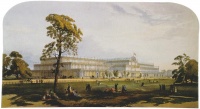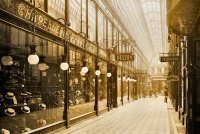Glass
From The Art and Popular Culture Encyclopedia
| Revision as of 12:37, 30 November 2014 Jahsonic (Talk | contribs) ← Previous diff |
Current revision Jahsonic (Talk | contribs) |
||
| Line 1: | Line 1: | ||
| [[Image:Glass half full or half empty.JPG|thumb|left|200px|[[Is the glass half empty or half full?]], photo © [[JWG]]]] | [[Image:Glass half full or half empty.JPG|thumb|left|200px|[[Is the glass half empty or half full?]], photo © [[JWG]]]] | ||
| + | |||
| + | [[Image:Delion at the Passage Jouffroy.jpg|thumb|right|200px|[[Passage Jouffroy]]]] | ||
| + | |||
| [[Image:The Crystal Palace.jpg|thumb|right|200px|This structure, built for the [[Great Exhibition]] of [[1851]], symbolizes the rise of [[modern architecture]] by its use of [[glass]] and [[steel]].]] | [[Image:The Crystal Palace.jpg|thumb|right|200px|This structure, built for the [[Great Exhibition]] of [[1851]], symbolizes the rise of [[modern architecture]] by its use of [[glass]] and [[steel]].]] | ||
| Line 11: | Line 14: | ||
| ==History== | ==History== | ||
| - | The history of creating glass can be traced back to 3500 BCE in [[Mesopotamia]]. | + | The history of creating glass can be traced back to [[3500 BCE]] in [[Mesopotamia]]. |
| The term ''glass'' developed in the late [[Roman Empire]]. It was in the [[Roman glass]]making center at [[Trier]], now in modern Germany, that the late-Latin term ''glesum'' originated, probably from a [[Germanic languages|Germanic]] word for a [[transparent materials|transparent]], [[lustrous]] substance. | The term ''glass'' developed in the late [[Roman Empire]]. It was in the [[Roman glass]]making center at [[Trier]], now in modern Germany, that the late-Latin term ''glesum'' originated, probably from a [[Germanic languages|Germanic]] word for a [[transparent materials|transparent]], [[lustrous]] substance. | ||
| ==See also== | ==See also== | ||
| Line 18: | Line 21: | ||
| * [[Glass eye]] | * [[Glass eye]] | ||
| * [[Glass ceiling]] | * [[Glass ceiling]] | ||
| + | * [[Lead glass]] | ||
| ===In art=== | ===In art=== | ||
| * [[Art glass]] | * [[Art glass]] | ||
| Line 33: | Line 37: | ||
| * [[The Glass Menagerie]] | * [[The Glass Menagerie]] | ||
| * [[The Hour-Glass Sanatorium]] | * [[The Hour-Glass Sanatorium]] | ||
| + | * [[Philip Glass]] | ||
| {{GFDL}} | {{GFDL}} | ||
Current revision

|
Related e |
|
Featured: |
Glass is an amorphous (non-crystalline) solid material. Glasses are typically brittle and optically transparent.
The most familiar type of glass, used for centuries in windows and drinking vessels. Often, the term glass is used in a restricted sense to refer to this specific use.
Glass, as a substance, plays an essential role in science and industry. Its chemical, physical, and in particular optical properties make it suitable for applications such as flat glass, container glass, optics and optoelectronics material, laboratory equipment, thermal insulator, reinforcement materials, and glass art (art glass, studio glass).
Contents |
History
The history of creating glass can be traced back to 3500 BCE in Mesopotamia. The term glass developed in the late Roman Empire. It was in the Roman glassmaking center at Trier, now in modern Germany, that the late-Latin term glesum originated, probably from a Germanic word for a transparent, lustrous substance.
See also
In art
Buildings
Namesakes



